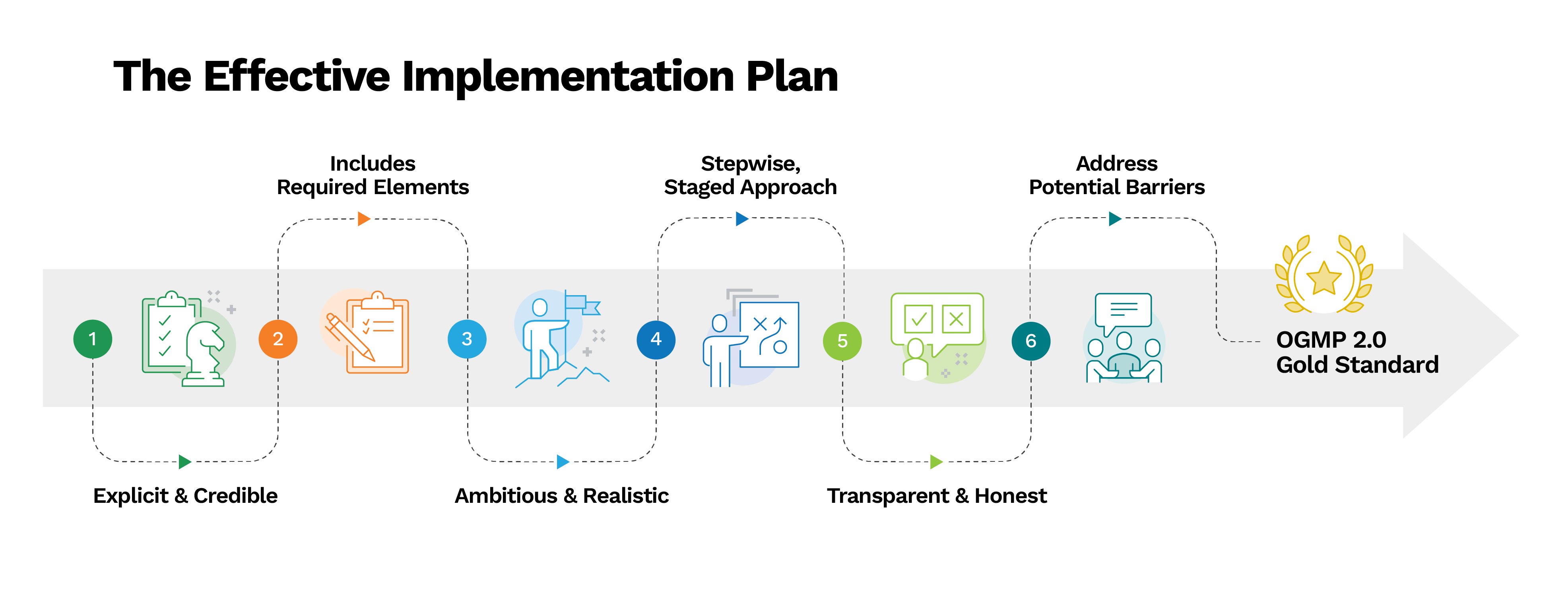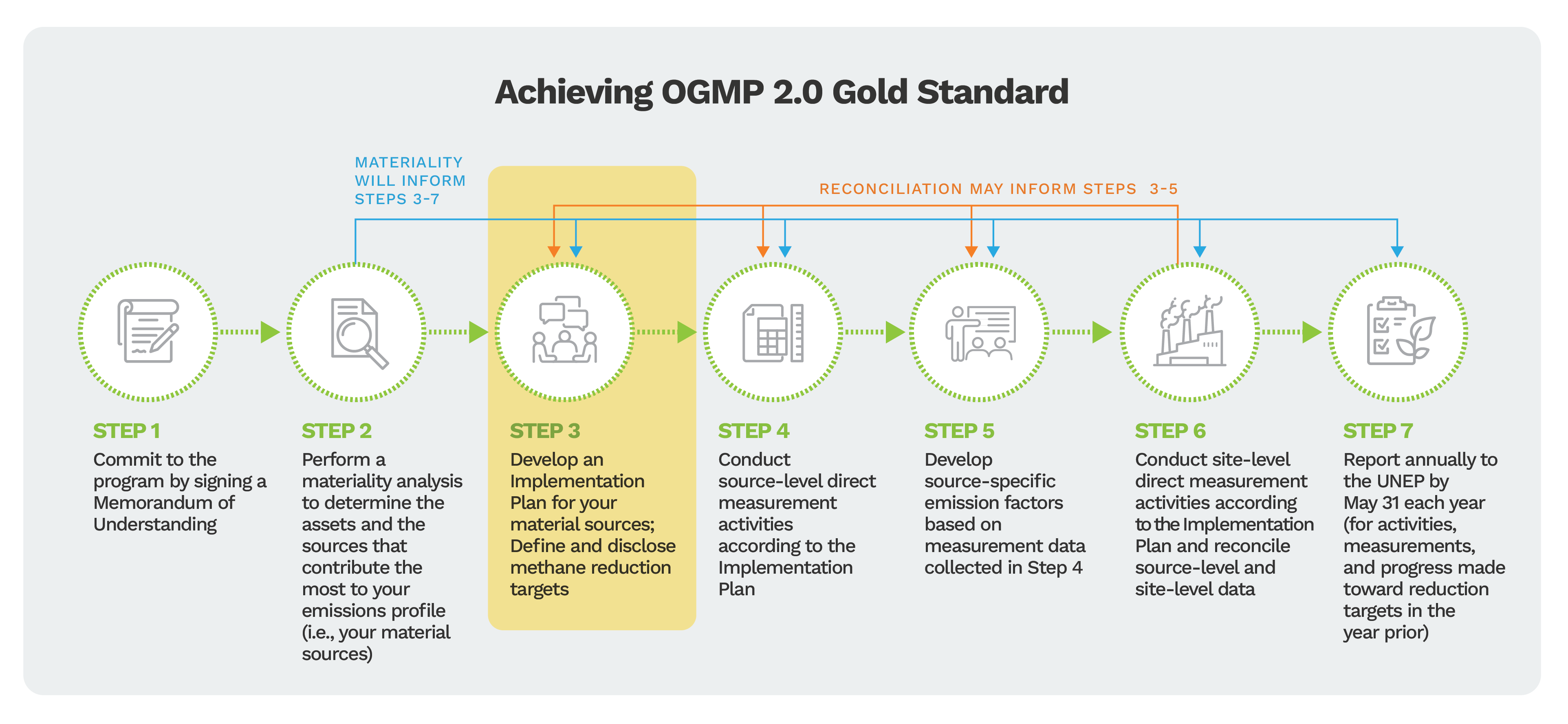
OGMP 2.0:
Developing a Credible Implementation Plan
April 12, 2024
By: Justin Merryman
The Path to OGMP 2.0 Gold Standard
For those of you that read OGMP 2.0 Part 1: The What and The Way, thank you!…and to those that haven’t, what are you waiting for? It includes an overview of the Oil and Gas Methane Partnership (OGMP 2.0) program, including its benefits and requirements. This second installment builds upon that volume with an in-depth look at the actual implementation of the OGMP 2.0 framework, centering around the development of an explicit and credible implementation plan.
If your company has signed a Memorandum of Understanding (MoU) with the United Nations Environment Programme (UNEP) to commit to OGMP 2.0, or if you are considering committing, you may be wondering what comes next. Member companies strive to achieve Gold Standard. Gold Standard is the destination, setting ambitious but achievable methane reduction targets is the North Star informing the program’s direction, and the OGMP 2.0 implementation plan is the roadmap to achieve the goal.
An effective implementation plan must be explicit, to provide clarity and avoid ambiguity, and credible, to maintain stakeholder commitment and confidence in the program. Based on our experience working hand-in-hand with our clients on their OGMP 2.0 journeys, we believe that an explicit and credible implementation plan must include UNEP required elements, should be informed through a stepwise staged approach, be ambitious, but realistic, transparent and honest (internally and externally), and identify known or potential barriers along the way…while always reflecting on the ultimate goal of reducing methane intensity through a full and transparent understanding of current emissions.

Required Elements
- Describe company targets
- Define the baseline year
- Identify the target date for Gold Standard
- Commit to reach L4/L5 by operated asset
- Show a credible and explicit path for OGMP 2.0 implementation for operated assets, including milestones
- List non-operated assets (if applicable)
- Commit to working with non-operated ventures
- Show an explicit and credible path for OGMP 2.0 implementation at non-operating assets, each with its own milestone as applicable
The required elements essentially outline the borders of the map to emissions reduction and achieving OGMP Gold Standard. They give an idea of what one would expect to find within, but the details of the implementation plan, i.e., the detailed map, is left up to the member company. Implementation plans are scored to evaluate whether a company should achieve the Pathway to Gold Standard designation. UNEP scores implementation plans to evaluate whether a company should achieve the Pathway to Gold Standard designation. Each required element of the plan is scored in a binary manner, with a one representing the element being in place and a zero score for absent or not reasonably demonstrated element. Companies reporting non-operated assets achieve Gold Standard with a score ≥ 8.5 points (of 9) and those without non-operated assets achieve Gold Standard with a score of ≥5.5 (of 6).
Ambitious and Realistic
As we are blazing our trail towards gold standard, we will encounter choices. We have a defined time to arrive at our destination but trying to swim across a river when you only dog paddle, in the effort to save a little time building a bridge, might not be a great plan. This is why being ambitious while being realistic is important. The goals your company is setting need to be ambitious but setting unrealistic goals is a sure way to fail.
For example, if a member company’s most material source is pneumatic controllers, they should consider the actual OGMP 2.0-aligned goal. Is it best to jump in and measure 10% of 10,000 pneumatics to develop emission factors, knowing the technical challenges and time required to do it properly? Or does the company need to look realistically at its inventory first? Are there significant gaps in records of their pneumatics? Are pneumatic malfunctions being recorded in leak detection and repair (LDAR) surveys? Are a subset of pneumatics being targeted for replacement with no-bleed devices as part of a regulatory compliance program? Additional considerations may include comparing the costs of installing instrument air or alternative emissions-free technology or retrofits, whether or not required for regulatory compliance. An effective and credible implementation plan may strike a balance between the ambition of an extensive measurement program and emissions reduction projects. Ambition and realism go hand in hand with a credible and explicit implementation plan.
Stepwise, Staged Approach
Continuing the roadmap analogy, if we don’t take our journey in a metered and measured manner, we are not going to know if we have selected the best route, and once we reach our destination we may not remember where we started. Therefore, an effective implementation plan outlines how to meet all requirements of the OGMP 2.0 framework in steps or stages. Each stage includes the problem definition, analysis, formulation, and monitoring is carried out in turn, making the process cyclical. An effective implementation plan demonstrates that as the evolution of the performance of the assets are tracked, the company will show a logical flow to Level 4 or 5 reporting across all assets, with the goal of achieving the gold standard of reporting within 3 years.
One common mistake we have seen is the commitment to move through OGMP Levels at breakneck pace. When a member develops a plan to move from Level 3 to Level 5 in one year, there may be omissions in the plan. For instance, the plan may be lacking the phasing aspect by assuming that all source-level and site-level measurements will be completed in a single year. It may be better to clearly outline that there may be phasing that leads to the member achieving Level 4 for some subset of sources but having to report at Level 3 (with the distance to Level 4 rapidly closing). Omitting the details of phasing risks the plan not being explicit.
Better practice is to show the stepped progression from L3 to L5. A stepwise staged plan provides clarity to all stakeholders about the elements themselves, the roles each will play within the framework and the opportunities to influence the outcomes, thus making it credible and explicit. A basic example of this might be developing an overly ambitious plan of measuring many pneumatics. Committing to measuring 100,000 pneumatics might not be a realistic goal for a single year based on the physical location of your assets. This is where taking a stepwise staged approach is valuable. The goal of Gold Standard is achievable, but trying to sprint to the finish doesn’t always produce the desired result.
Transparent and Honest
Equally as critical to the elements discussed above is stakeholder engagement. This is where transparency and internal honesty come into play. Your credible implementation plan shows both your external and internal stakeholders your intended path, and, when done correctly, will ensure buy-in and commitment to both the program and reaching intended goals.
An effective implementation plan will honestly identify gaps in current measurement and quantification programs and clearly outline an approach to meet OGMP 2.0 requirements. For example, you may have regulatory-driven detection or measurement programs in place, but additional evaluation is required to meet OGMP requirements. Your plan should clearly outline what needs to be added to the program and why, and a plan to achieve it. Without this level of explicit detail, you risk leaving unresolved gaps in your data. In contrast, by clearly outlining steps to implement according to the OGMP 2.0 framework, your measurement teams will understand the needed steps to close gaps, and stakeholders will trust the gaps are being addressed. This is critical to a successful OGMP 2.0 journey.
It is also important to remember that your reduction targets will also be publicly disclosed. There is importance both internally and externally on the transparency and honesty of your implementation plan. Therefore, this aspect is a critical component of a credible and explicit plan.
Potential Barriers
We have discussed the important components of our implementation plan roadmap, but what about the barriers or stumbling blocks we may encounter along the way? There are possible barriers at every level, but the important thing to remember is that a credible and explicit implementation plan will preemptively identify and eliminate some barriers before they become an issue, and a trusted advisor can be invaluable in this process. An example of a potential barrier can be as simple as selecting a measurement technology. OGMP is intentionally technology-agnostic and allows companies to select the measurement technology they feel most appropriate to collect emission data based on actual operations and site-specific concerns. There is a lot at stake for our journey by selecting the wrong measurement technology, and that mistake could be as costly as taking the wrong fork in the road. It may not end our journey, but it could delay us in reaching our destination on time. The outcome of your measurements may not match expectations. Was this because you selected an unproven technology for your measurements? You may wish you had a trustworthy advisor to help you decide which path might reach the Gold Standard destination more efficiently. Having a partner that has been through the process before, as Montrose has, to identify potential barriers before the initial or updated implementation plan is submitted can be greatly beneficial in making the journey as efficient as possible.
Conclusion
The journey to Gold Standard requires a roadmap in the form of an implementation plan to inform internal and external stakeholders. To be effective, that roadmap should be credible and explicit and meet all framework requirements. It should also be approached using a stepwise staged approach, be ambitious but realistic working towards a true understanding of your emissions profile, be transparent and internally honest and with an eye towards the potential barriers along the journey. Along with a trusted trailblazing partner like Montrose to help develop and refine your implementation plan, you can set aside your fears about getting lost in the OGMP 2.0 wilderness and get on the pathway to Gold Standard!

Don’t miss the next blog in this series, where we will discuss in detail the elements of a successful technology pilot program!
 Justin Merryman,
Justin Merryman,
Senior Associate, Direct Measurements
Justin has over 23 years of environmental consulting and project management experience. His expertise includes direct measurement and quantification of emissions, source stack testing for compliance with state and federal regulations, original equipment manufacturing (OEM) guarantee testing and auditing, greenhouse gas (GHG) quantification, Oil & Gas Methane Partnership 2.0 (OGMP 2.0) direct measurement, project management and reporting. Justin has worked in over 35 countries outside of the United States (U.S.), including Germany, Italy, Ireland, Saudi Arabia, United Arab Emirates, Yemen, Argentina, Chile, Mexico, Spain, and Qatar. He manages projects for clients in multiple industries such as oil and gas, electric power generation, wood and paper products, chemical manufacturing, food products, steel production, cement, power startups, and industrial boilers. He specializes in assisting clients with GHG quantification, stack emissions testing, laboratory analysis, state and federal air compliance reporting, emission quantification and regulatory applicability analyses. Justin also has significant experience in developing and presenting custom classroom trainings on topics including GHG quantification and reporting, New Source Performance Standard (NSPS) compliance across multiple industries, oil and gas compliance, and environmental compliance.


